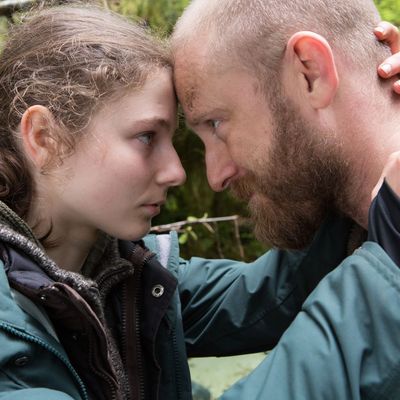
Of all modern feminist directors, Debra Granik is the most mournful. Not for her the fierce recriminations at the heart of so many female-empowerment sagas. The heroines of her three, agonizing fictional features — Irene (Vera Farmiga) in Down to the Bone, Ree Dolly (Jennifer Lawrence) in Winter’s Bone, and now 13-year-old Tom (Thomasin Harcourt McKenzie) in Leave No Trace — want desperately to save the men in their lives from pride, addiction, and a host of other maladaptive male drives. But these men are such febrile creatures, both fragile and terrified of being seen as such. And so, with a sad glance back, the women and girls forge onward. They have themselves, children, and the whole of human society to preserve. Someone has to.
Leave No Trace’s maladaptive male authority is Will (Ben Foster), a traumatized vet who lives with his daughter in the eight-square-mile Forest Park in the mountains west of Portland, Oregon. This is, of course, highly illegal, as is keeping Tom out of school, but it’s a while before Granik gives us our bearings: For the first 20 minutes, we might be watching a survival tale from the distant past or postapocalyptic future. What’s clear is that Will and Tom have an easy, tender relationship. Will doesn’t need the company of others, while the girl — whose mother died when she was very young — has known no other way. It’s only after a violent change of circumstances that Tom understands there might be other viable designs for living.
Leave No Trace is based on a novel called My Abandonment by Peter Rock, who was inspired by a story he read in the Oregonian. What likely attracted Granik was the idea that a father who sees himself as his daughter’s savior in a perilous world could actually be imperiling her — and that he’d continue to do so until the world (or, preferably, the daughter) severs the cord. But there isn’t an instant in which Granik loses sympathy for Will or sight of what’s rare and precious in this relationship.
Foster and the New Zealand–born McKenzie seem keyed to each other’s rhythms, even each other’s thoughts. The acting is extraordinary. Foster’s Will is in permanent fight-or-flight mode, but he can’t tell the signals from the static — his receptors are fuzzed. His alienation has seeped into McKenzie’s Tom, with her watchful gray eyes on a face too grown-up for her years. She speaks haltingly, as if words were unnatural and, in any case, too dear to waste on inessentials.
But the seeds of Tom’s future autonomy are planted even before the state swoops in. On one of the pair’s occasional trips to Portland for food and medicine, she sees a table in the lobby of the VA hospital offering vets and their families such items as a “gun block” for sticking in a barrel if, as a counselor puts it, “someone wants to do something to himself or others.” Tom realizes that there are other people like her father, perhaps worse off. Slowly, it comes to her that the world in which he lives isn’t necessarily hers and that his damaged psyche doesn’t need to be yoked to her own.
Granik, who wrote the screenplay with Anne Rosellini, has an anthropological fascination with people who live far off the grid, with how their seemingly makeshift ways have ancient roots, as if coded into human DNA. The revelation in Winter’s Bone was that the egregiously male-dominated hill country had firm matriarchal underpinnings. That notion appears here in more benign form: a community of outsiders living in shacks and trailers in the woods of Washington State that appears godforsaken but has its own nurturing ecosystem. Dale Dickey, unforgettable as the cruel but judicious Merab in Winter’s Bone, plays a considerably softer matriarch in Leave No Trace. There turns out to be a vast middle ground between the woods and the jangly, abrasive city. People bond deeply with nature — with rabbits, dogs, and, in a memorable sequence, bees. Around them, the tension goes out of Tom’s body. After a childhood in the woods, Tom senses another path that’s truer to her soul.
I saw Leave No Trace at its Sundance Film Festival premiere, where the audience was still shaking from the momentous final scene when Granik and her cast and crew took the stage. I was reminded of that reading a recent review of a new George Bernard Shaw biography in the London Review of Books, in which Terry Eagleton pokes fun at Shaw’s “weird metaphysical reasons for valuing women highly: It was through them that the life force went about its stealthy work.” But there was nothing weird about the force I felt coming from that stage, along with a collective faith — not so stealthy — in the power of art to capture the harshness of the physical world and still point the way to an all-embracing, undying life of the spirit.
This review has been updated since its original publication after the Sundance Film Festival.
*This article appears in the June 25, 2018, issue of New York Magazine. Subscribe Now!





